
July 16, 1945
 The Trinity detonation.
The Trinity detonation. In 1940 a mere $6000 was granted for research into the development of a weapon of mass destruction but soon that budget limit was removed with the United States entering World War 2. The original budget of $6000 blew out to a total cost of more than $2 billion for the development of the super weapon.
On the morning of July 16, 1945 a successful test of the first atomic weapon was carried out. Observers watched from about 10,000 yards away (9100 meters) however although calculations had been carried out no one was entirely sure what was going to happen next.
When the weapon was detonated, there was a blinding light followed closely after by a rumbling explosion and the iconic 'mushroom cloud'. The explosive force was measured at around equal to 15000-20000 tons of TNT being exploded.
Now with a deliverable weapon it came the time to use it. Germany had already surrendered so on 6th August that same year, barely three weeks after the successful test, Hiroshima, Japan was the first city to have the new weapon dropped on it causing between 90,000 and 166,000 people to lose their lives. Three days later Nagasaki, Japan also felt the weapons destructive power. It has not been used in wartime since.
July 19, 1799
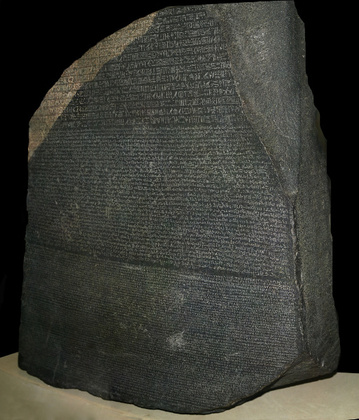 The Rosetta Stone.
The Rosetta Stone. The Rosetta Stone is a dark grey-pinkish stone of granite, although it was originally thought to have been basalt. It was discovered on 19 July 1799 by French Captain Pierre-François Bouchard during Napoleon Bonaparte's campaign in Egypt. The irregularly shaped stone inscribed with ancient writing was found near the town of Rosetta, approximately 60km north of Alexandria.
The stone contained fragments of passages written in three different scripts: Greek, Egyptian hieroglyphics and Demotic Egyptian. The Greek passage stated that all three scripts were identical in meaning. Because Greek was well known, the stone was the key to deciphering the hieroglyphs, a language that had been considered dead for two thousand years.
Twenty five years later, French Egyptologist Jean Francois Champollion successfully deciphered the hieroglyphics, using the Greek as a guide. This enabled further study of Egyptian hieroglyphics which had previously been indecipherable. It was the first time that the world became aware of the depth of the history and culture of ancient Egypt. "
(from Web Management Technologies)
July 21, 1925
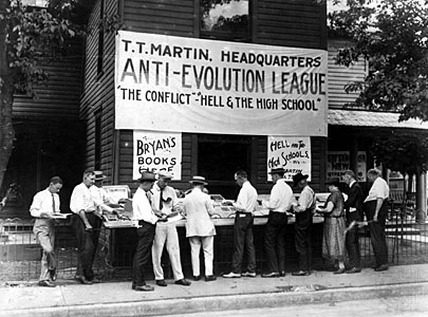 Both sides of the trial had a good turn out.
Both sides of the trial had a good turn out. Two months later the American Civil Liberties Union sought out a teacher who was willing to challenge the Butler Law. The idea was for a teacher to teach evolution in a class, get indicted for breaking the Butler Law and see it come to trial. John Thomas Scopes, a 24 year old teacher from Dayton, Tennessee agrees to be the candidate and is indicted by a grand jury.
What ensued was quite the circus, publicity was massive, parts of the town were entirely transformed in expectation of the weird tourism that was sure to commence and camps were erected close to the court house.
The courtroom itself was fitted out with the latest technology so the trial could be broadcast live to the masses. The trial opened on July 10.
The proceedings were opened with a prayer. The defence team argued that the law was unconstitutional, violates freedom of religion and is the destruction of learning.
 Man -chimp... a go at the theory of evolution.
Man -chimp... a go at the theory of evolution. In the summer heat the trial was moved out to the lawns, into the carnival like atmosphere. The chief prosecutor William Bryan was subjected to severe ridicule as he was essentially forced to concede that a literal interpretation of the bible was impossible.
In the end Scopes was found guilty (the defence actually requesting the verdict in order to appeal and get a retrial) and ordered to pay a fine of $100 to which he responds: "to oppose this law in any way I can. Any other action would be in violation of my ideal of academic freedom — that is, to teach the truth as guaranteed in our constitution, of personal and religious freedom."
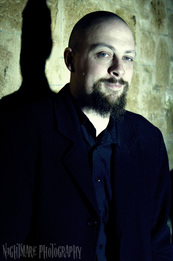
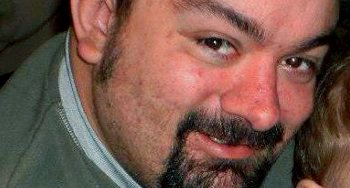


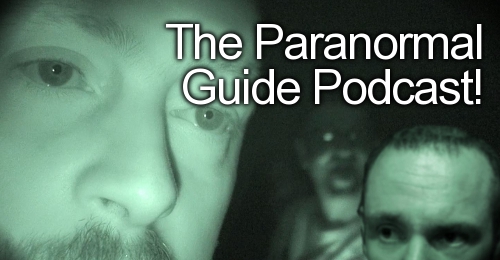
 RSS Feed
RSS Feed
